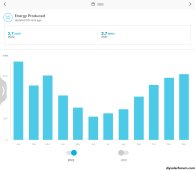Hi
I have a newbie question. I’m putting panels on the roof of my house. The panels will face due north (I’m in New Zealand) however my (flat) roof pitches slightly down to the south. All the solar installers I’ve spoken to are keen to mount the panels with tilt legs so that the pitch of the roof is corrected and the panels with face the sun straight on at midday.
I’m keen to install the panels flat on the roof and accept that the pitch does not directly face the sun. I know this is not optimal for generation, but:
- tilting legs are expensive, I can use that money to buy and install more panels
- using legs to tilt the panels up will be less attractive than our current streamlined roof
So my question is how much generation will I loose due to the sub-optimal pitch of panels? If they will generate 50% less power I’m wondering if I can just install twice the number of panels to address this.
I know i'm late to this party but ... there are very few *
offgrid* situations in the design phase where the cost of tilt kits is justified in a capital cost vs production assessment
when compared to adding more panels.
Some of the situations where tilt kits are justified are;
- The angle away from the sun is large
- The roof space is a limiting factor
- Additional panels cannot be found that match the spec (although this is found in the re-design or upgrade phase, not the design phase)
The underlying principals for this are;
- In general, for offgrid, you need to capture your baseline energy requirements on as many days as possible,
not maximise your theoretical energy capture on the best days, or put another way, maximise the worst days capture, not the best days.
- If you maximise your energy capture on direct-sun days, you will be necessarily hurting your energy capture on scattered-light (overcast) days
- The optimal clean-panel angle for overcast days is zero degrees (ie dead flat, allowing the panel to capture light from the whole hemisphere above you)
What comes from these principals are these ideas;
- most of the time, adding more panels will be a better solution
- aluminium (mounts and tilt kits) generate no power, so invest in panels not mounts
Once you get into the design phase where you are picking your panels and controllers then other rules might start to influence your decisions, such as your controller's max Voc.
In NZ you won't see solar farms with low angles, because overcast days are a write-off for them, (they make about 30% compared to a direct-sun day), and instead they are optimised for direct-sun days (which is logical given they are there to make money, not provide daily reliable power)



